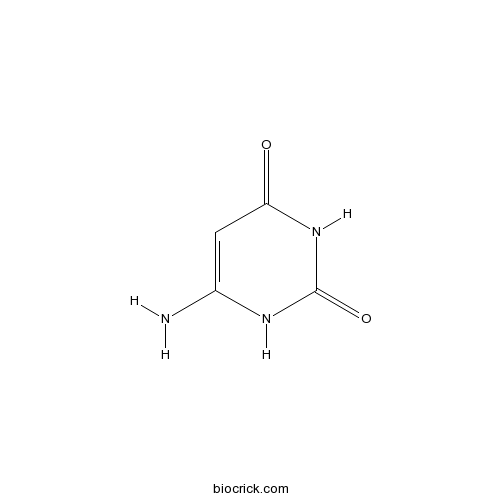6-AminouracilCAS# 873-83-6 |

Quality Control & MSDS
3D structure
Package In Stock
Number of papers citing our products

| Cas No. | 873-83-6 | SDF | Download SDF |
| PubChem ID | 70120 | Appearance | Powder |
| Formula | C4H5N3O2 | M.Wt | 127 |
| Type of Compound | N/A | Storage | Desiccate at -20°C |
| Solubility | Soluble in Chloroform,Dichloromethane,Ethyl Acetate,DMSO,Acetone,etc. | ||
| Chemical Name | 6-amino-1H-pyrimidine-2,4-dione | ||
| SMILES | C1=C(NC(=O)NC1=O)N | ||
| Standard InChIKey | LNDZXOWGUAIUBG-UHFFFAOYSA-N | ||
| Standard InChI | InChI=1S/C4H5N3O2/c5-2-1-3(8)7-4(9)6-2/h1H,(H4,5,6,7,8,9) | ||
| General tips | For obtaining a higher solubility , please warm the tube at 37 ℃ and shake it in the ultrasonic bath for a while.Stock solution can be stored below -20℃ for several months. We recommend that you prepare and use the solution on the same day. However, if the test schedule requires, the stock solutions can be prepared in advance, and the stock solution must be sealed and stored below -20℃. In general, the stock solution can be kept for several months. Before use, we recommend that you leave the vial at room temperature for at least an hour before opening it. |
||
| About Packaging | 1. The packaging of the product may be reversed during transportation, cause the high purity compounds to adhere to the neck or cap of the vial.Take the vail out of its packaging and shake gently until the compounds fall to the bottom of the vial. 2. For liquid products, please centrifuge at 500xg to gather the liquid to the bottom of the vial. 3. Try to avoid loss or contamination during the experiment. |
||
| Shipping Condition | Packaging according to customer requirements(5mg, 10mg, 20mg and more). Ship via FedEx, DHL, UPS, EMS or other couriers with RT, or blue ice upon request. | ||

6-Aminouracil Dilution Calculator

6-Aminouracil Molarity Calculator
| 1 mg | 5 mg | 10 mg | 20 mg | 25 mg | |
| 1 mM | 7.874 mL | 39.3701 mL | 78.7402 mL | 157.4803 mL | 196.8504 mL |
| 5 mM | 1.5748 mL | 7.874 mL | 15.748 mL | 31.4961 mL | 39.3701 mL |
| 10 mM | 0.7874 mL | 3.937 mL | 7.874 mL | 15.748 mL | 19.685 mL |
| 50 mM | 0.1575 mL | 0.7874 mL | 1.5748 mL | 3.1496 mL | 3.937 mL |
| 100 mM | 0.0787 mL | 0.3937 mL | 0.7874 mL | 1.5748 mL | 1.9685 mL |
| * Note: If you are in the process of experiment, it's necessary to make the dilution ratios of the samples. The dilution data above is only for reference. Normally, it's can get a better solubility within lower of Concentrations. | |||||

Calcutta University

University of Minnesota

University of Maryland School of Medicine

University of Illinois at Chicago

The Ohio State University

University of Zurich

Harvard University

Colorado State University

Auburn University

Yale University

Worcester Polytechnic Institute

Washington State University

Stanford University

University of Leipzig

Universidade da Beira Interior

The Institute of Cancer Research

Heidelberg University

University of Amsterdam

University of Auckland

TsingHua University

The University of Michigan

Miami University

DRURY University

Jilin University

Fudan University

Wuhan University

Sun Yat-sen University

Universite de Paris

Deemed University

Auckland University

The University of Tokyo

Korea University
- 3-Methoxyoxohernandaline
Catalog No.:BCN8107
CAS No.:872729-34-5
- 1,2,3,10-Tetramethoxy-9-(2-hydroxy-4,5-dimethoxybenzyloxy)oxoaporphine
Catalog No.:BCN8120
CAS No.:872729-33-4
- Dabigatran etexilate mesylate
Catalog No.:BCC1511
CAS No.:872728-81-9
- MEDICA 16
Catalog No.:BCC7956
CAS No.:87272-20-6
- 7-Epi-5-eudesmene-1beta,11-diol
Catalog No.:BCN7701
CAS No.:87261-77-6
- Ro 3306
Catalog No.:BCC4007
CAS No.:872573-93-8
- BGJ398
Catalog No.:BCC1278
CAS No.:872511-34-7
- (+)-Noe's reagent
Catalog No.:BCC8377
CAS No.:87248-50-8
- Bijaponicaxanthone C
Catalog No.:BCN6884
CAS No.:872409-35-3
- NVP-QAV680
Catalog No.:BCC5508
CAS No.:872365-16-7
- Dipraglurant
Catalog No.:BCC1531
CAS No.:872363-17-2
- K 114
Catalog No.:BCC5984
CAS No.:872201-12-2
- 3,29-Dibenzoyl karounitriol
Catalog No.:BCN2717
CAS No.:873001-54-8
- Ivacaftor (VX-770)
Catalog No.:BCC2478
CAS No.:873054-44-5
- Ganoderone A
Catalog No.:BCN2448
CAS No.:873061-79-1
- IKK-16 (IKK Inhibitor VII)
Catalog No.:BCC4555
CAS No.:873225-46-8
- AIM-100
Catalog No.:BCC1333
CAS No.:873305-35-2
- Ramipril
Catalog No.:BCC5012
CAS No.:87333-19-5
- 1,7-Dihydroxy-4-methoxyxanthone
Catalog No.:BCN7602
CAS No.:87339-76-2
- TC-P 262
Catalog No.:BCC6155
CAS No.:873398-67-5
- Fortuneine
Catalog No.:BCN6401
CAS No.:87340-25-8
- Triangularine
Catalog No.:BCN2051
CAS No.:87340-27-0
- PU-H71
Catalog No.:BCC1872
CAS No.:873436-91-0
- Lupeolic acid
Catalog No.:BCN6520
CAS No.:87355-32-6
Chromophoric Nucleoside Analogues: Synthesis and Characterization of 6-Aminouracil-Based Nucleodyes.[Pubmed:27128151]
J Org Chem. 2016 Jun 3;81(11):4530-9.
Nucleodyes, visibly colored chromophoric nucleoside analogues, are reported. Design criteria are outlined and the syntheses of cytidine and uridine azo dye analogues derived from 6-Aminouracil are described. Structural analysis shows that the nucleodyes are sound structural analogues of their native nucleoside counterparts, and photophysical studies demonstrate that the nucleodyes are sensitive to microenvironmental changes. Quantum chemical calculations are presented as a valuable complementary tool for the design of strongly absorbing nucleodyes, which overlap with the emission of known fluorophores. Forster critical distance (R0) calculations determine that the nucleodyes make good FRET pairs with both 2-aminopurine (2AP) and pyrrolocytosine (PyC). Additionally, unique tautomerization features exhibited by 5-(4-nitrophenylazo)-6-oxocytidine (8) are visualized by an extraordinary crystal structure.
Three new pseudopolymorphs of 6-aminouracil.[Pubmed:24192197]
Acta Crystallogr C. 2013 Nov;69(Pt 11):1402-7.
Since 6-Aminouracil derivatives show diversified use in various fields of application, we crystallized 6-Aminouracil to examine its preferred hydrogen-bonding frameworks. 6-Aminouracil shows two rigid hydrogen-bonding sites, viz. one acceptor-donor-acceptor (ADA) site and one donor-donor-acceptor (DDA) site. During various crystallization attempts, we obtained three structures, namely two dimethylacetamide monosolvates, C4H5N3O2.C4H9NO, and a 1-methylpyrrolidin-2-one monosolvate, C4H5N3O2.C5H9NO. In all three structures, R2(1)(6) N-H...O hydrogen-bonding patterns link the molecules to their respective solvent molecules. The formation of R2(2)(8) N-H...O hydrogen-bond motifs between 6-Aminouracil molecules can only be found in two-dimensional frameworks, whereas R3(3)(14) N-H...O patterns are present when zigzag chzins of 6-Aminouracil molecules are formed.


